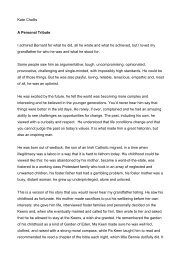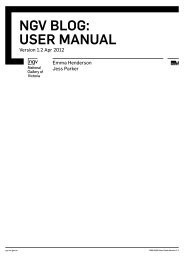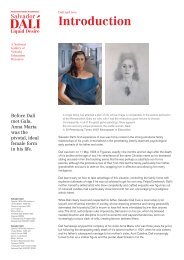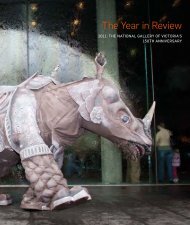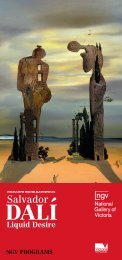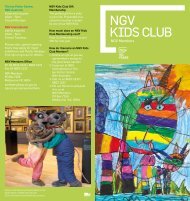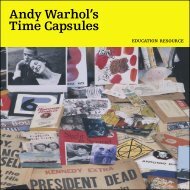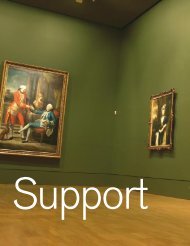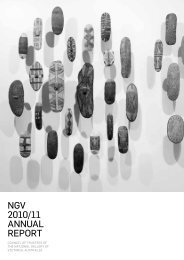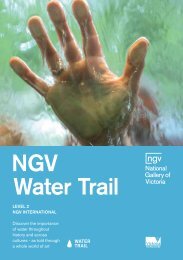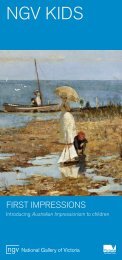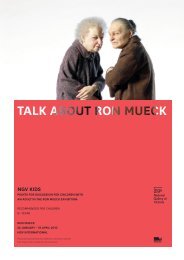Australia's Father of Art History - National Gallery of Victoria
Australia's Father of Art History - National Gallery of Victoria
Australia's Father of Art History - National Gallery of Victoria
You also want an ePaper? Increase the reach of your titles
YUMPU automatically turns print PDFs into web optimized ePapers that Google loves.
Sheridan Palmer<br />
NGV Tribute<br />
Bernard Smith - Australia’s father <strong>of</strong> art history.<br />
I came to know Bernard Smith late in his life as his biographer, when he was reflecting on<br />
a long and distinguished career, turning every polemical stone and contemplating his<br />
own final curtain call. He was a formidable and brilliant inter-disciplinarian who had<br />
steered a critical course through much <strong>of</strong> art history’s movements, especially those <strong>of</strong> the<br />
nineteenth and twentieth centuries, but it was his ability to lift art out <strong>of</strong> its narrow<br />
confines towards a global historical reading that won him the reputation as Australia’s<br />
most eminent art historian.<br />
Bernard Smith’s development as an art historian was unique. Initially self trained, he<br />
aligned himself with writers, poets, artists, unionists, the Contemporary <strong>Art</strong> Society and<br />
the Communist party during the 1940s in Sydney, but it was his friendship with a number<br />
<strong>of</strong> exiled European scholars and artists that prompted him to consider Europe as his<br />
Antipodes. Indeed Bernard’s concept <strong>of</strong> antipodeanism was about where one stood in<br />
relation to elsewhere. His first book Place, Taste & Tradition published in 1945<br />
deciphered the shifts in Australia’s cultural development and it also clinched him a<br />
scholarship to study at the Warburg and Courtauld Institutes in London where he<br />
developed his pioneering thesis on European Vision and the South Pacific. This history <strong>of</strong><br />
British colonisation and cross-cultural exchanges looked at the root <strong>of</strong> contact between<br />
dominant imperial powers and the peripheral cultures <strong>of</strong> the Pacific region and it is still<br />
recognized today by many scholars as Bernard’s masterpiece.<br />
The last time I spoke in this great hall was at another important art historian’s memorial<br />
tribute, that <strong>of</strong> Dr Ursula H<strong>of</strong>f, a valued colleague and a good friend <strong>of</strong> Bernard. When<br />
looking at a work <strong>of</strong> art, Ursula H<strong>of</strong>f would ask, ‘Now tell me what do you see’. Bernard<br />
however, would ask ‘Now how can we define it’. This encapsulates his approach to both<br />
his work and life. A work <strong>of</strong> art, like a person, or a suburb, had to be contextualised,<br />
historically situated within his, her or its social and cultural framework, have an origin and<br />
an end. Looking backwards and defining the contours <strong>of</strong> culture, ideas and art was<br />
cardinal for Bernard in understanding the present — it meant identifying and anchoring<br />
objects and styles in time and place.<br />
Identity also concerned Bernard Smith. He believed that Australia’s identity developed<br />
initially under conditions <strong>of</strong> cultural displacement and geographical distance as well as<br />
the guilt associated with native dispossession. Moreover, he recognised his own
limitations when addressing aboriginal art and culture, but as he said, he was neither an<br />
anthropologist, nor was Aboriginal art visible in the middle decades <strong>of</strong> last century,<br />
except ‘in small doses, and in artistically marginalised spaces’. 1 Bernard’s historical<br />
revision <strong>of</strong> Australia’s cultural developments was Eurocentrically based and not from an<br />
Indigenous cultural perspective, but this changed when he gave his 1980 Boyer Lectures,<br />
The Spectre <strong>of</strong> Truganini. In this powerful treatise on the state <strong>of</strong> indigenous Australians<br />
he evoked the past — ‘the colonial crime’ — as tragedy and the present as having the<br />
potential for redemptive liberation. These inspirational lectures, for many who heard<br />
them, awakened the need for a legitimate nationhood amongst Aboriginal people.<br />
Bernard Smith was something <strong>of</strong> ‘a politician <strong>of</strong> the arts’, and was <strong>of</strong>ten prepared to stake<br />
his career on major aesthetic and socio-political issues. In the 1940s it was with social<br />
realism; in 1959 it was the ‘Antipodean exhibition and its manifesto’; in 1961 ‘the myth <strong>of</strong><br />
isolation’;<br />
2<br />
and in the late 1960s and 70s, with his wife Kate, it was the fight to save the<br />
suburb <strong>of</strong> Glebe with its distinctive Federation architecture from freeway destruction. In<br />
1992, after Karl Duldig’s ceramic relief sculpture was destroyed in St Kilda Road, Bernard<br />
was instrumental in <strong>Art</strong>s <strong>Victoria</strong> and the <strong>National</strong> Trust collaborating to establish a<br />
register <strong>of</strong> all public works <strong>of</strong> art in the State <strong>of</strong> <strong>Victoria</strong>. Preserving the past and its<br />
traditions was paramount to him and whether he was looking at a picture by one <strong>of</strong><br />
Captain Cook’s artist’s or a painting by Richard Larter, he felt the past informed the<br />
present.<br />
As art history’s éminence grise, Bernard approached his ninth decade with vigour and<br />
refused to be dislodged by generational change, deciding to identify and name the<br />
beginnings and the end <strong>of</strong> Modernism. His swansong The Formalesque was published in<br />
his 92 nd year. In 2006, Ron Radford wrote to Bernard.<br />
You are our greatest living historian, our finest scholar in the humanities and one <strong>of</strong><br />
the few … to establish a world reputation while working on the ‘antipodes’... We are<br />
immensely grateful to you for all you have done for Australian art and for Australia. 3<br />
And finally, one thing remains undisputed, Bernard Smith was not only a major player in<br />
the course <strong>of</strong> Australian art history; he defined it.<br />
Thank you.<br />
1 Daniel Thomas, ‘Aboriginal <strong>Art</strong> as <strong>Art</strong>: Who was interested’, paper given at New Visions: Histories <strong>of</strong> <strong>Art</strong> in Australia, NGV<br />
International, 3 June 2006.<br />
2 David Boyd interviewed by Sheridan Palmer 14 September 2009. NLA .Oral <strong>History</strong> Project oh-6111-0002-0002<br />
3 Ron Radford to Bernard Smith, nd, c. October 2006, Bernard Smith Papers Acc. 10.088, box 56, <strong>National</strong> Library <strong>of</strong> Australia



